NUR104 Assessment Task 2: Workbook 40% (Revised 4/09/2019)
VerifiedAdded on 2022/11/14
|8
|2584
|312
AI Summary
This document contains responses to questions related to older people and their care. It discusses the advantages and challenges of older people remaining in their own homes, how an older person can get assessed through My Aged Care to get the services they need, the role of Older Persons Advocacy Network (OPAN) in informing the support and protection of older people in Australia, University of the Third Age (U3A), age-related changes contributing to increased risk of urinary tract infection (UTI), and ageism in the context of health care services.
Contribute Materials
Your contribution can guide someone’s learning journey. Share your
documents today.
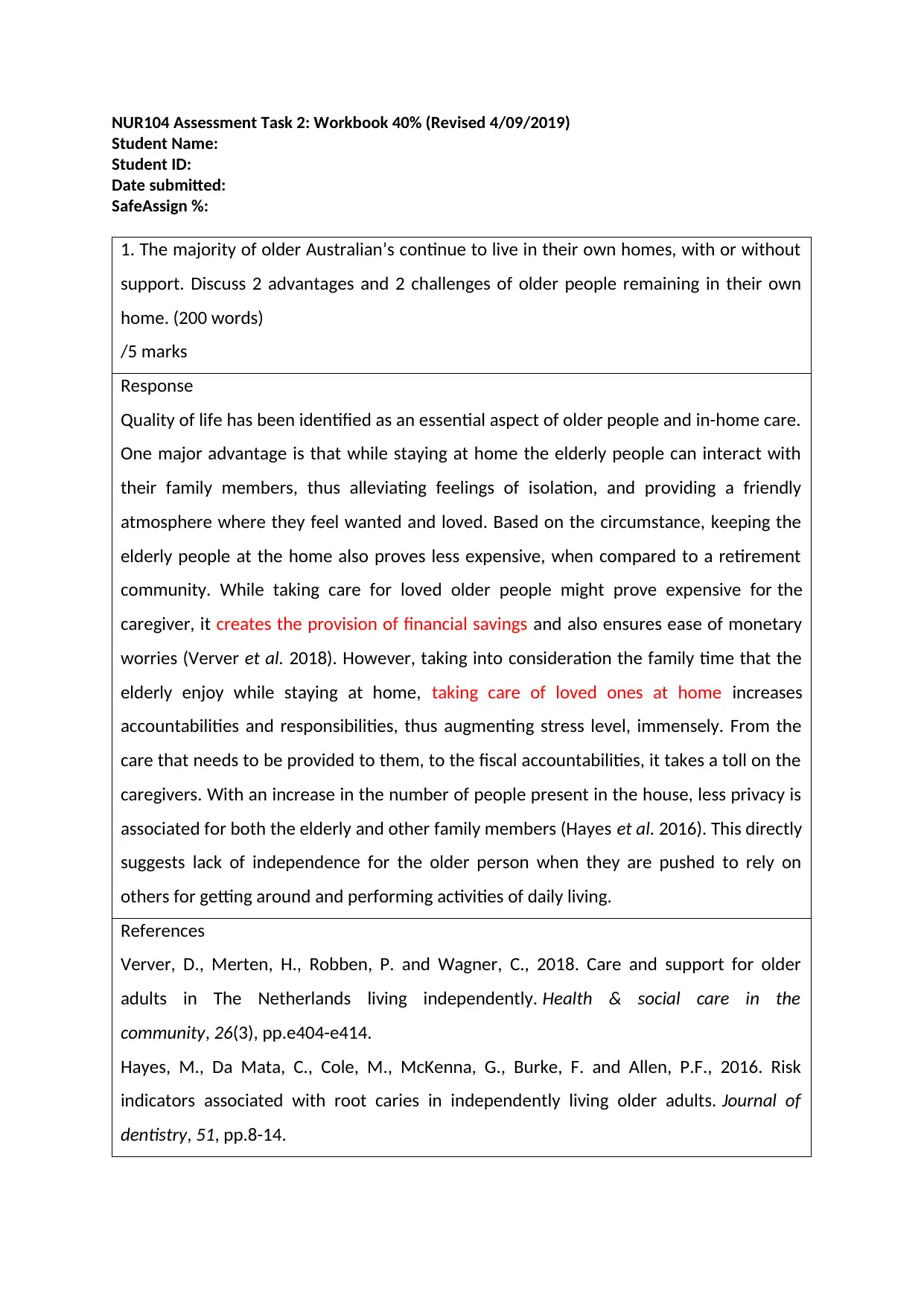
NUR104 Assessment Task 2: Workbook 40% (Revised 4/09/2019)
Student Name:
Student ID:
Date submitted:
SafeAssign %:
1. The majority of older Australian’s continue to live in their own homes, with or without
support. Discuss 2 advantages and 2 challenges of older people remaining in their own
home. (200 words)
/5 marks
Response
Quality of life has been identified as an essential aspect of older people and in-home care.
One major advantage is that while staying at home the elderly people can interact with
their family members, thus alleviating feelings of isolation, and providing a friendly
atmosphere where they feel wanted and loved. Based on the circumstance, keeping the
elderly people at the home also proves less expensive, when compared to a retirement
community. While taking care for loved older people might prove expensive for the
caregiver, it creates the provision of financial savings and also ensures ease of monetary
worries (Verver et al. 2018). However, taking into consideration the family time that the
elderly enjoy while staying at home, taking care of loved ones at home increases
accountabilities and responsibilities, thus augmenting stress level, immensely. From the
care that needs to be provided to them, to the fiscal accountabilities, it takes a toll on the
caregivers. With an increase in the number of people present in the house, less privacy is
associated for both the elderly and other family members (Hayes et al. 2016). This directly
suggests lack of independence for the older person when they are pushed to rely on
others for getting around and performing activities of daily living.
References
Verver, D., Merten, H., Robben, P. and Wagner, C., 2018. Care and support for older
adults in The Netherlands living independently. Health & social care in the
community, 26(3), pp.e404-e414.
Hayes, M., Da Mata, C., Cole, M., McKenna, G., Burke, F. and Allen, P.F., 2016. Risk
indicators associated with root caries in independently living older adults. Journal of
dentistry, 51, pp.8-14.
Student Name:
Student ID:
Date submitted:
SafeAssign %:
1. The majority of older Australian’s continue to live in their own homes, with or without
support. Discuss 2 advantages and 2 challenges of older people remaining in their own
home. (200 words)
/5 marks
Response
Quality of life has been identified as an essential aspect of older people and in-home care.
One major advantage is that while staying at home the elderly people can interact with
their family members, thus alleviating feelings of isolation, and providing a friendly
atmosphere where they feel wanted and loved. Based on the circumstance, keeping the
elderly people at the home also proves less expensive, when compared to a retirement
community. While taking care for loved older people might prove expensive for the
caregiver, it creates the provision of financial savings and also ensures ease of monetary
worries (Verver et al. 2018). However, taking into consideration the family time that the
elderly enjoy while staying at home, taking care of loved ones at home increases
accountabilities and responsibilities, thus augmenting stress level, immensely. From the
care that needs to be provided to them, to the fiscal accountabilities, it takes a toll on the
caregivers. With an increase in the number of people present in the house, less privacy is
associated for both the elderly and other family members (Hayes et al. 2016). This directly
suggests lack of independence for the older person when they are pushed to rely on
others for getting around and performing activities of daily living.
References
Verver, D., Merten, H., Robben, P. and Wagner, C., 2018. Care and support for older
adults in The Netherlands living independently. Health & social care in the
community, 26(3), pp.e404-e414.
Hayes, M., Da Mata, C., Cole, M., McKenna, G., Burke, F. and Allen, P.F., 2016. Risk
indicators associated with root caries in independently living older adults. Journal of
dentistry, 51, pp.8-14.
Secure Best Marks with AI Grader
Need help grading? Try our AI Grader for instant feedback on your assignments.
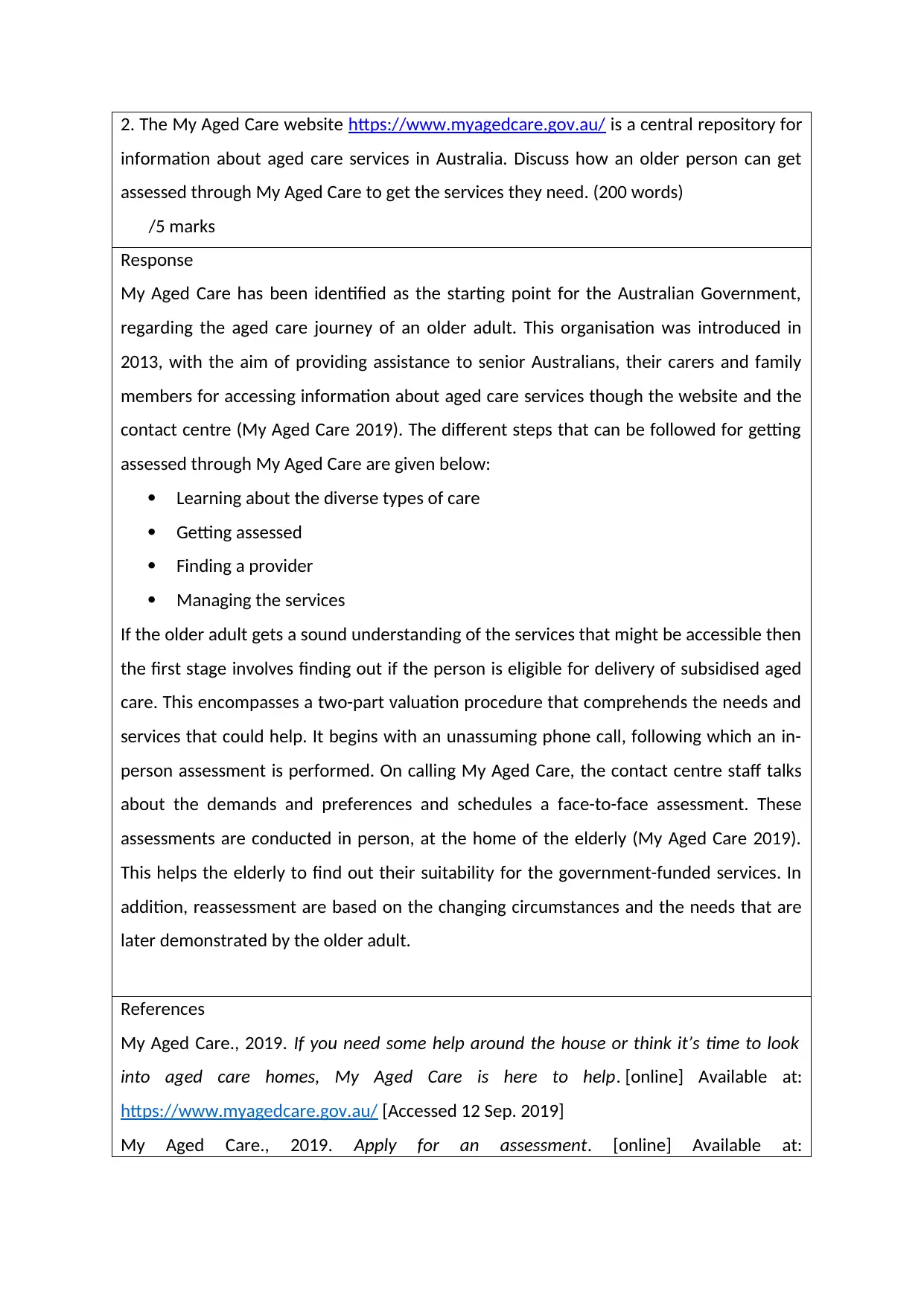
2. The My Aged Care website https://www.myagedcare.gov.au/ is a central repository for
information about aged care services in Australia. Discuss how an older person can get
assessed through My Aged Care to get the services they need. (200 words)
/5 marks
Response
My Aged Care has been identified as the starting point for the Australian Government,
regarding the aged care journey of an older adult. This organisation was introduced in
2013, with the aim of providing assistance to senior Australians, their carers and family
members for accessing information about aged care services though the website and the
contact centre (My Aged Care 2019). The different steps that can be followed for getting
assessed through My Aged Care are given below:
Learning about the diverse types of care
Getting assessed
Finding a provider
Managing the services
If the older adult gets a sound understanding of the services that might be accessible then
the first stage involves finding out if the person is eligible for delivery of subsidised aged
care. This encompasses a two-part valuation procedure that comprehends the needs and
services that could help. It begins with an unassuming phone call, following which an in-
person assessment is performed. On calling My Aged Care, the contact centre staff talks
about the demands and preferences and schedules a face-to-face assessment. These
assessments are conducted in person, at the home of the elderly (My Aged Care 2019).
This helps the elderly to find out their suitability for the government-funded services. In
addition, reassessment are based on the changing circumstances and the needs that are
later demonstrated by the older adult.
References
My Aged Care., 2019. If you need some help around the house or think it’s time to look
into aged care homes, My Aged Care is here to help. [online] Available at:
https://www.myagedcare.gov.au/ [Accessed 12 Sep. 2019]
My Aged Care., 2019. Apply for an assessment. [online] Available at:
information about aged care services in Australia. Discuss how an older person can get
assessed through My Aged Care to get the services they need. (200 words)
/5 marks
Response
My Aged Care has been identified as the starting point for the Australian Government,
regarding the aged care journey of an older adult. This organisation was introduced in
2013, with the aim of providing assistance to senior Australians, their carers and family
members for accessing information about aged care services though the website and the
contact centre (My Aged Care 2019). The different steps that can be followed for getting
assessed through My Aged Care are given below:
Learning about the diverse types of care
Getting assessed
Finding a provider
Managing the services
If the older adult gets a sound understanding of the services that might be accessible then
the first stage involves finding out if the person is eligible for delivery of subsidised aged
care. This encompasses a two-part valuation procedure that comprehends the needs and
services that could help. It begins with an unassuming phone call, following which an in-
person assessment is performed. On calling My Aged Care, the contact centre staff talks
about the demands and preferences and schedules a face-to-face assessment. These
assessments are conducted in person, at the home of the elderly (My Aged Care 2019).
This helps the elderly to find out their suitability for the government-funded services. In
addition, reassessment are based on the changing circumstances and the needs that are
later demonstrated by the older adult.
References
My Aged Care., 2019. If you need some help around the house or think it’s time to look
into aged care homes, My Aged Care is here to help. [online] Available at:
https://www.myagedcare.gov.au/ [Accessed 12 Sep. 2019]
My Aged Care., 2019. Apply for an assessment. [online] Available at:
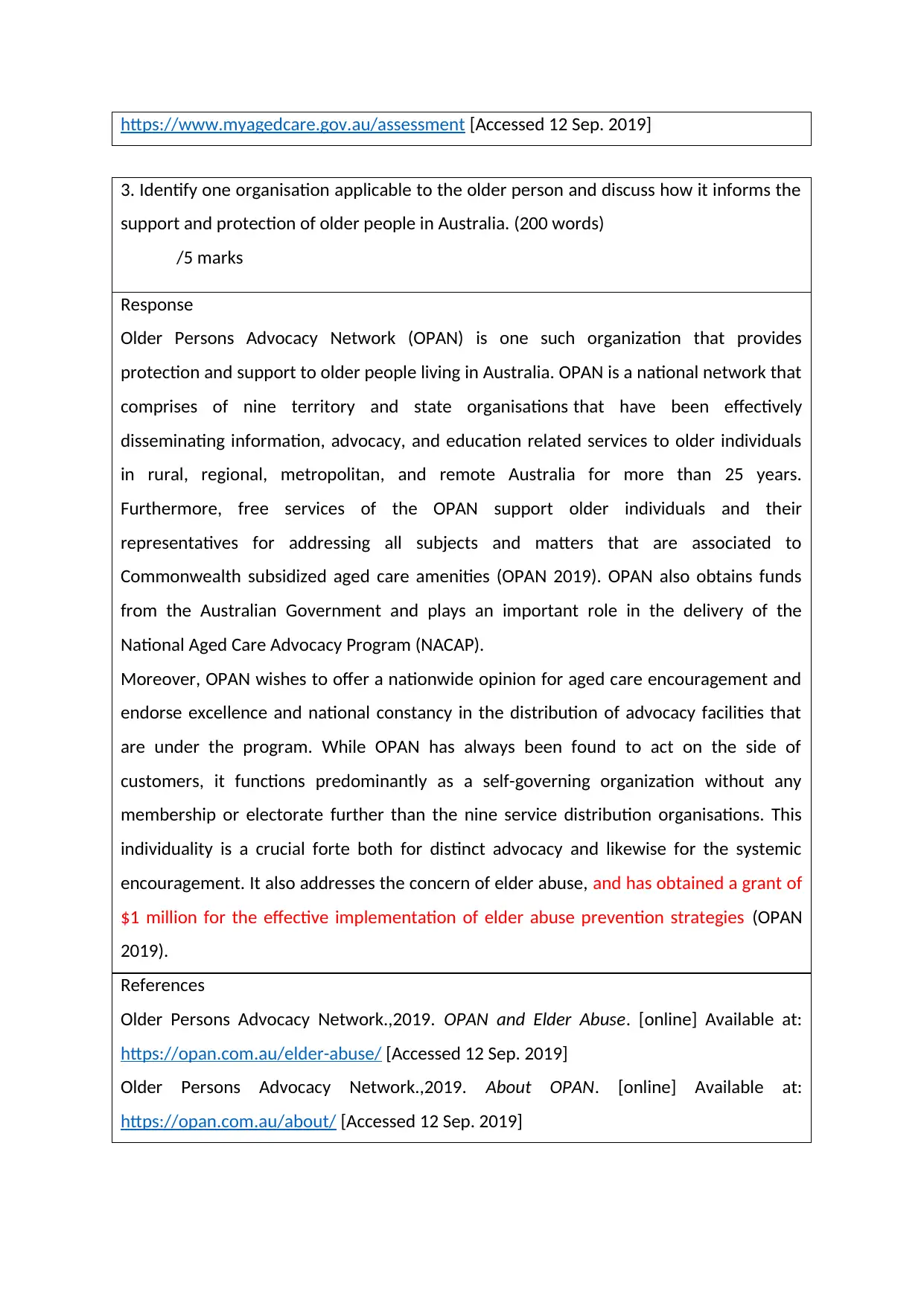
https://www.myagedcare.gov.au/assessment [Accessed 12 Sep. 2019]
3. Identify one organisation applicable to the older person and discuss how it informs the
support and protection of older people in Australia. (200 words)
/5 marks
Response
Older Persons Advocacy Network (OPAN) is one such organization that provides
protection and support to older people living in Australia. OPAN is a national network that
comprises of nine territory and state organisations that have been effectively
disseminating information, advocacy, and education related services to older individuals
in rural, regional, metropolitan, and remote Australia for more than 25 years.
Furthermore, free services of the OPAN support older individuals and their
representatives for addressing all subjects and matters that are associated to
Commonwealth subsidized aged care amenities (OPAN 2019). OPAN also obtains funds
from the Australian Government and plays an important role in the delivery of the
National Aged Care Advocacy Program (NACAP).
Moreover, OPAN wishes to offer a nationwide opinion for aged care encouragement and
endorse excellence and national constancy in the distribution of advocacy facilities that
are under the program. While OPAN has always been found to act on the side of
customers, it functions predominantly as a self-governing organization without any
membership or electorate further than the nine service distribution organisations. This
individuality is a crucial forte both for distinct advocacy and likewise for the systemic
encouragement. It also addresses the concern of elder abuse, and has obtained a grant of
$1 million for the effective implementation of elder abuse prevention strategies (OPAN
2019).
References
Older Persons Advocacy Network.,2019. OPAN and Elder Abuse. [online] Available at:
https://opan.com.au/elder-abuse/ [Accessed 12 Sep. 2019]
Older Persons Advocacy Network.,2019. About OPAN. [online] Available at:
https://opan.com.au/about/ [Accessed 12 Sep. 2019]
3. Identify one organisation applicable to the older person and discuss how it informs the
support and protection of older people in Australia. (200 words)
/5 marks
Response
Older Persons Advocacy Network (OPAN) is one such organization that provides
protection and support to older people living in Australia. OPAN is a national network that
comprises of nine territory and state organisations that have been effectively
disseminating information, advocacy, and education related services to older individuals
in rural, regional, metropolitan, and remote Australia for more than 25 years.
Furthermore, free services of the OPAN support older individuals and their
representatives for addressing all subjects and matters that are associated to
Commonwealth subsidized aged care amenities (OPAN 2019). OPAN also obtains funds
from the Australian Government and plays an important role in the delivery of the
National Aged Care Advocacy Program (NACAP).
Moreover, OPAN wishes to offer a nationwide opinion for aged care encouragement and
endorse excellence and national constancy in the distribution of advocacy facilities that
are under the program. While OPAN has always been found to act on the side of
customers, it functions predominantly as a self-governing organization without any
membership or electorate further than the nine service distribution organisations. This
individuality is a crucial forte both for distinct advocacy and likewise for the systemic
encouragement. It also addresses the concern of elder abuse, and has obtained a grant of
$1 million for the effective implementation of elder abuse prevention strategies (OPAN
2019).
References
Older Persons Advocacy Network.,2019. OPAN and Elder Abuse. [online] Available at:
https://opan.com.au/elder-abuse/ [Accessed 12 Sep. 2019]
Older Persons Advocacy Network.,2019. About OPAN. [online] Available at:
https://opan.com.au/about/ [Accessed 12 Sep. 2019]
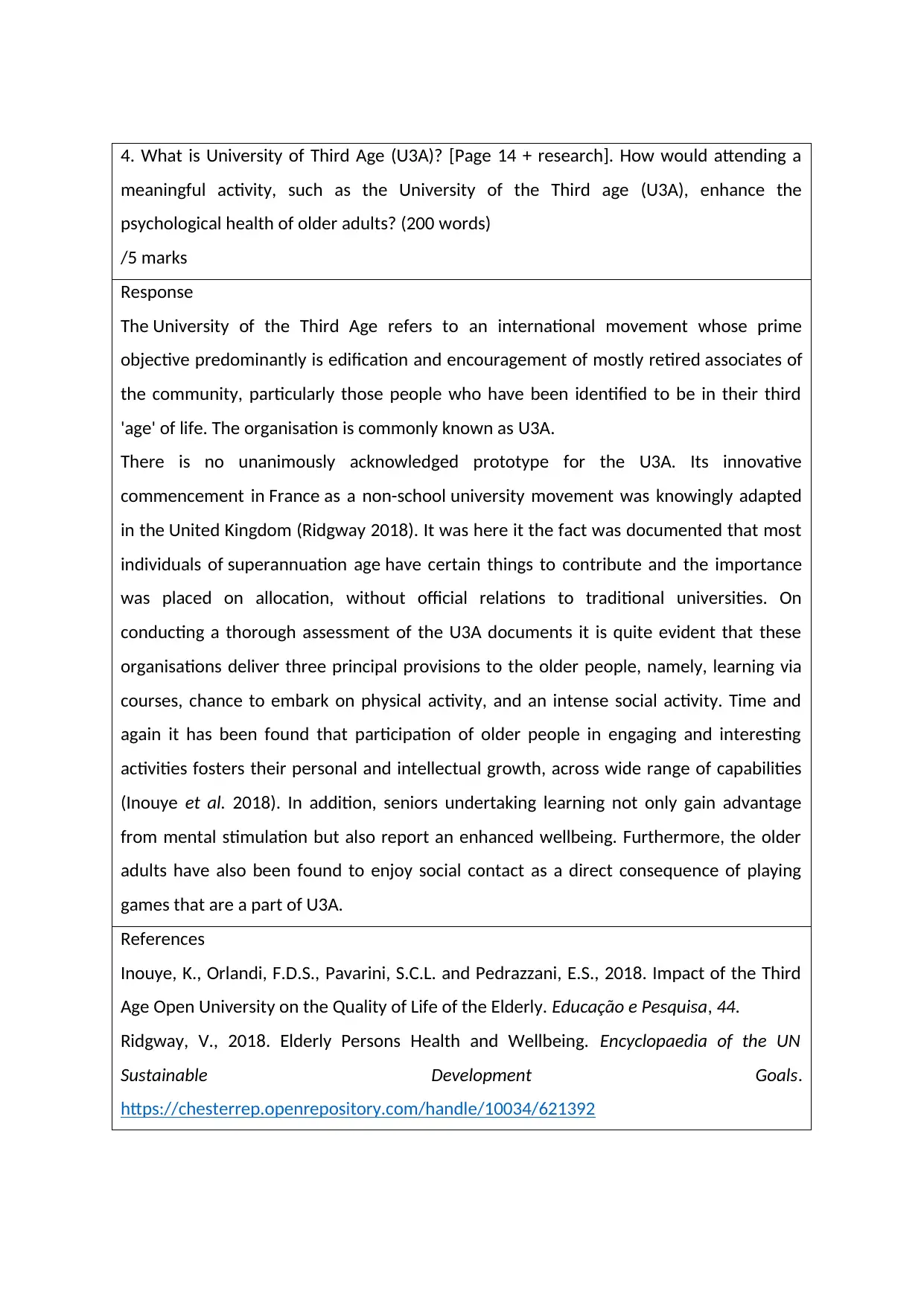
4. What is University of Third Age (U3A)? [Page 14 + research]. How would attending a
meaningful activity, such as the University of the Third age (U3A), enhance the
psychological health of older adults? (200 words)
/5 marks
Response
The University of the Third Age refers to an international movement whose prime
objective predominantly is edification and encouragement of mostly retired associates of
the community, particularly those people who have been identified to be in their third
'age' of life. The organisation is commonly known as U3A.
There is no unanimously acknowledged prototype for the U3A. Its innovative
commencement in France as a non-school university movement was knowingly adapted
in the United Kingdom (Ridgway 2018). It was here it the fact was documented that most
individuals of superannuation age have certain things to contribute and the importance
was placed on allocation, without official relations to traditional universities. On
conducting a thorough assessment of the U3A documents it is quite evident that these
organisations deliver three principal provisions to the older people, namely, learning via
courses, chance to embark on physical activity, and an intense social activity. Time and
again it has been found that participation of older people in engaging and interesting
activities fosters their personal and intellectual growth, across wide range of capabilities
(Inouye et al. 2018). In addition, seniors undertaking learning not only gain advantage
from mental stimulation but also report an enhanced wellbeing. Furthermore, the older
adults have also been found to enjoy social contact as a direct consequence of playing
games that are a part of U3A.
References
Inouye, K., Orlandi, F.D.S., Pavarini, S.C.L. and Pedrazzani, E.S., 2018. Impact of the Third
Age Open University on the Quality of Life of the Elderly. Educação e Pesquisa, 44.
Ridgway, V., 2018. Elderly Persons Health and Wellbeing. Encyclopaedia of the UN
Sustainable Development Goals.
https://chesterrep.openrepository.com/handle/10034/621392
meaningful activity, such as the University of the Third age (U3A), enhance the
psychological health of older adults? (200 words)
/5 marks
Response
The University of the Third Age refers to an international movement whose prime
objective predominantly is edification and encouragement of mostly retired associates of
the community, particularly those people who have been identified to be in their third
'age' of life. The organisation is commonly known as U3A.
There is no unanimously acknowledged prototype for the U3A. Its innovative
commencement in France as a non-school university movement was knowingly adapted
in the United Kingdom (Ridgway 2018). It was here it the fact was documented that most
individuals of superannuation age have certain things to contribute and the importance
was placed on allocation, without official relations to traditional universities. On
conducting a thorough assessment of the U3A documents it is quite evident that these
organisations deliver three principal provisions to the older people, namely, learning via
courses, chance to embark on physical activity, and an intense social activity. Time and
again it has been found that participation of older people in engaging and interesting
activities fosters their personal and intellectual growth, across wide range of capabilities
(Inouye et al. 2018). In addition, seniors undertaking learning not only gain advantage
from mental stimulation but also report an enhanced wellbeing. Furthermore, the older
adults have also been found to enjoy social contact as a direct consequence of playing
games that are a part of U3A.
References
Inouye, K., Orlandi, F.D.S., Pavarini, S.C.L. and Pedrazzani, E.S., 2018. Impact of the Third
Age Open University on the Quality of Life of the Elderly. Educação e Pesquisa, 44.
Ridgway, V., 2018. Elderly Persons Health and Wellbeing. Encyclopaedia of the UN
Sustainable Development Goals.
https://chesterrep.openrepository.com/handle/10034/621392
Secure Best Marks with AI Grader
Need help grading? Try our AI Grader for instant feedback on your assignments.
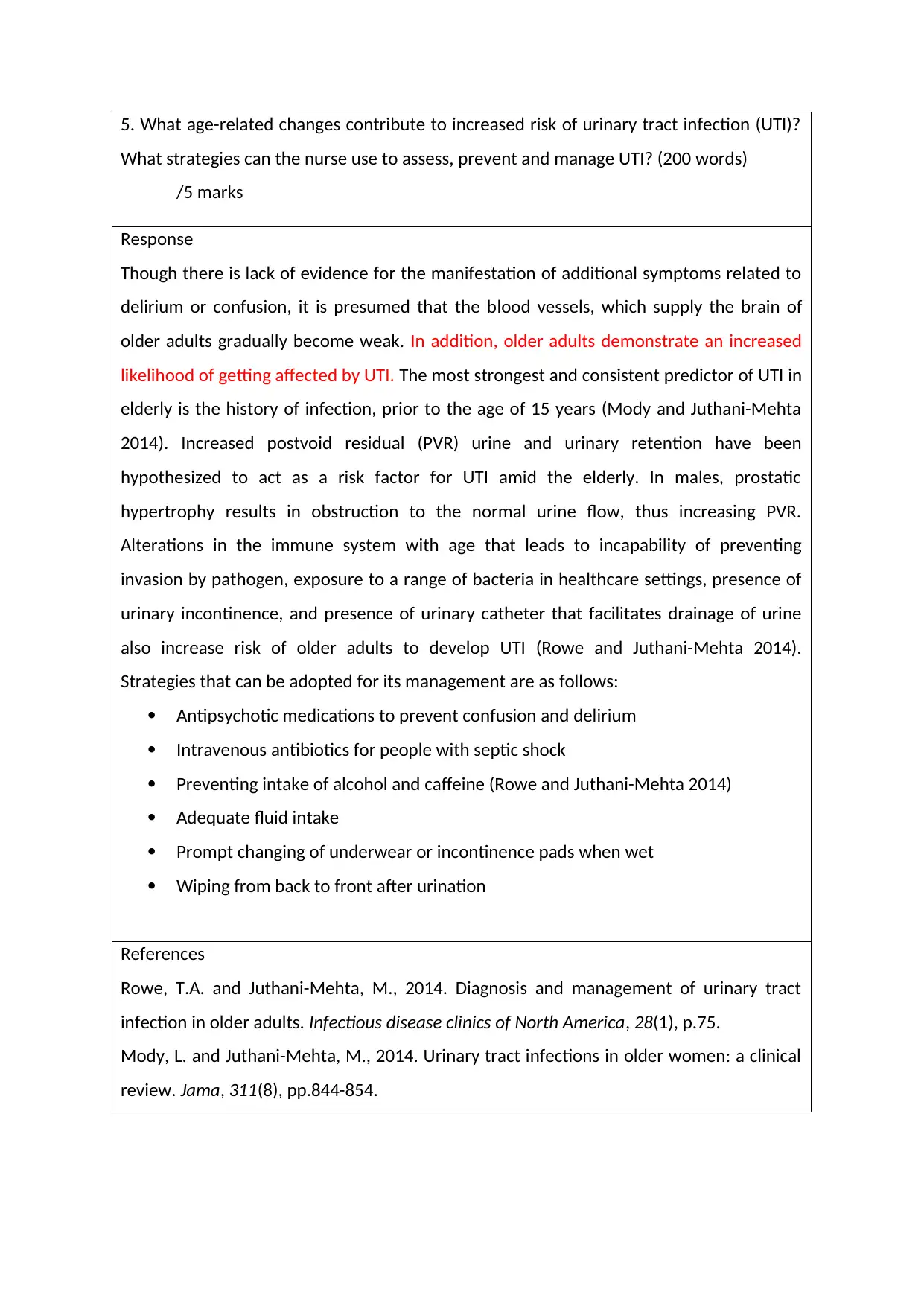
5. What age-related changes contribute to increased risk of urinary tract infection (UTI)?
What strategies can the nurse use to assess, prevent and manage UTI? (200 words)
/5 marks
Response
Though there is lack of evidence for the manifestation of additional symptoms related to
delirium or confusion, it is presumed that the blood vessels, which supply the brain of
older adults gradually become weak. In addition, older adults demonstrate an increased
likelihood of getting affected by UTI. The most strongest and consistent predictor of UTI in
elderly is the history of infection, prior to the age of 15 years (Mody and Juthani-Mehta
2014). Increased postvoid residual (PVR) urine and urinary retention have been
hypothesized to act as a risk factor for UTI amid the elderly. In males, prostatic
hypertrophy results in obstruction to the normal urine flow, thus increasing PVR.
Alterations in the immune system with age that leads to incapability of preventing
invasion by pathogen, exposure to a range of bacteria in healthcare settings, presence of
urinary incontinence, and presence of urinary catheter that facilitates drainage of urine
also increase risk of older adults to develop UTI (Rowe and Juthani-Mehta 2014).
Strategies that can be adopted for its management are as follows:
Antipsychotic medications to prevent confusion and delirium
Intravenous antibiotics for people with septic shock
Preventing intake of alcohol and caffeine (Rowe and Juthani-Mehta 2014)
Adequate fluid intake
Prompt changing of underwear or incontinence pads when wet
Wiping from back to front after urination
References
Rowe, T.A. and Juthani-Mehta, M., 2014. Diagnosis and management of urinary tract
infection in older adults. Infectious disease clinics of North America, 28(1), p.75.
Mody, L. and Juthani-Mehta, M., 2014. Urinary tract infections in older women: a clinical
review. Jama, 311(8), pp.844-854.
What strategies can the nurse use to assess, prevent and manage UTI? (200 words)
/5 marks
Response
Though there is lack of evidence for the manifestation of additional symptoms related to
delirium or confusion, it is presumed that the blood vessels, which supply the brain of
older adults gradually become weak. In addition, older adults demonstrate an increased
likelihood of getting affected by UTI. The most strongest and consistent predictor of UTI in
elderly is the history of infection, prior to the age of 15 years (Mody and Juthani-Mehta
2014). Increased postvoid residual (PVR) urine and urinary retention have been
hypothesized to act as a risk factor for UTI amid the elderly. In males, prostatic
hypertrophy results in obstruction to the normal urine flow, thus increasing PVR.
Alterations in the immune system with age that leads to incapability of preventing
invasion by pathogen, exposure to a range of bacteria in healthcare settings, presence of
urinary incontinence, and presence of urinary catheter that facilitates drainage of urine
also increase risk of older adults to develop UTI (Rowe and Juthani-Mehta 2014).
Strategies that can be adopted for its management are as follows:
Antipsychotic medications to prevent confusion and delirium
Intravenous antibiotics for people with septic shock
Preventing intake of alcohol and caffeine (Rowe and Juthani-Mehta 2014)
Adequate fluid intake
Prompt changing of underwear or incontinence pads when wet
Wiping from back to front after urination
References
Rowe, T.A. and Juthani-Mehta, M., 2014. Diagnosis and management of urinary tract
infection in older adults. Infectious disease clinics of North America, 28(1), p.75.
Mody, L. and Juthani-Mehta, M., 2014. Urinary tract infections in older women: a clinical
review. Jama, 311(8), pp.844-854.
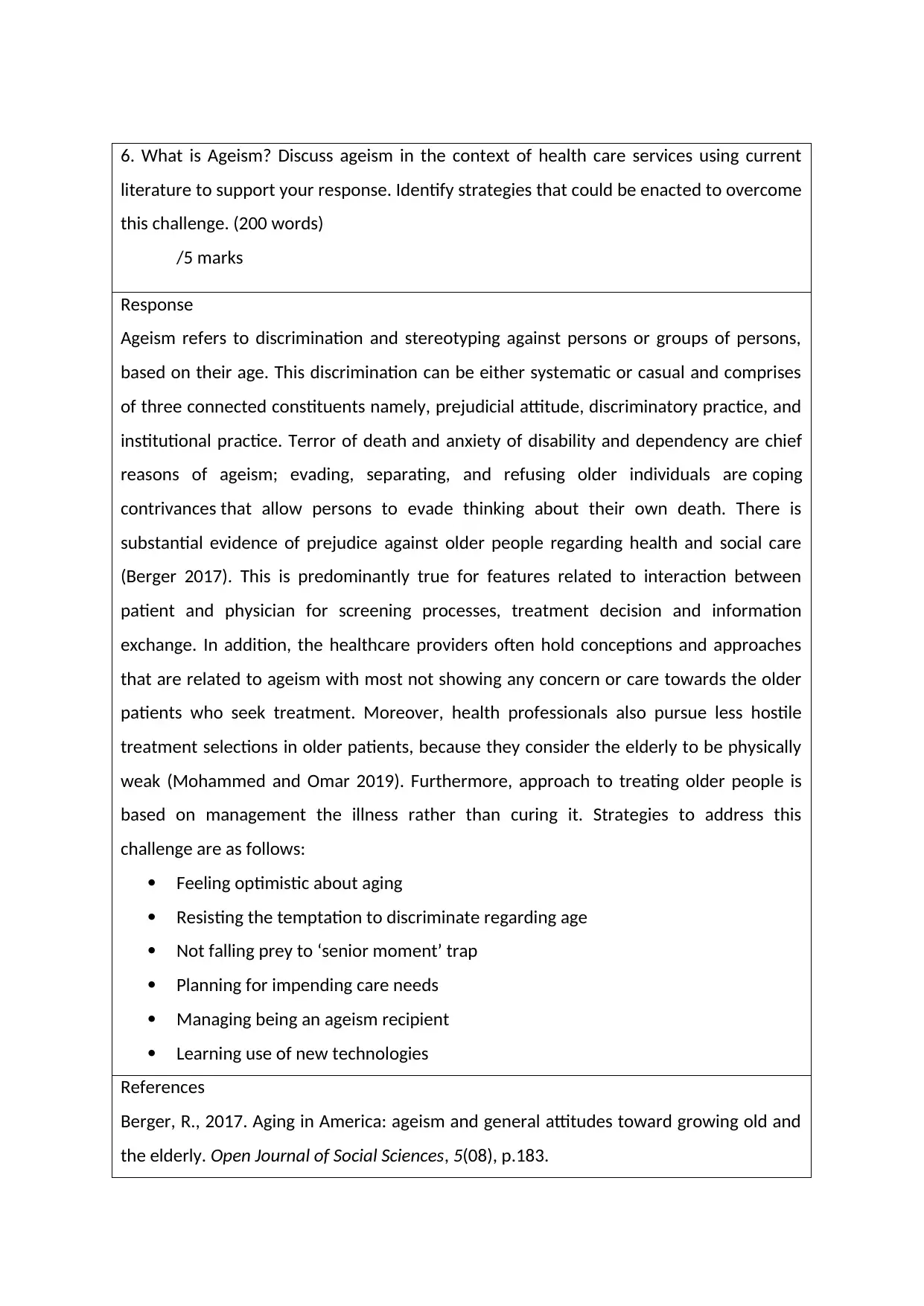
6. What is Ageism? Discuss ageism in the context of health care services using current
literature to support your response. Identify strategies that could be enacted to overcome
this challenge. (200 words)
/5 marks
Response
Ageism refers to discrimination and stereotyping against persons or groups of persons,
based on their age. This discrimination can be either systematic or casual and comprises
of three connected constituents namely, prejudicial attitude, discriminatory practice, and
institutional practice. Terror of death and anxiety of disability and dependency are chief
reasons of ageism; evading, separating, and refusing older individuals are coping
contrivances that allow persons to evade thinking about their own death. There is
substantial evidence of prejudice against older people regarding health and social care
(Berger 2017). This is predominantly true for features related to interaction between
patient and physician for screening processes, treatment decision and information
exchange. In addition, the healthcare providers often hold conceptions and approaches
that are related to ageism with most not showing any concern or care towards the older
patients who seek treatment. Moreover, health professionals also pursue less hostile
treatment selections in older patients, because they consider the elderly to be physically
weak (Mohammed and Omar 2019). Furthermore, approach to treating older people is
based on management the illness rather than curing it. Strategies to address this
challenge are as follows:
Feeling optimistic about aging
Resisting the temptation to discriminate regarding age
Not falling prey to ‘senior moment’ trap
Planning for impending care needs
Managing being an ageism recipient
Learning use of new technologies
References
Berger, R., 2017. Aging in America: ageism and general attitudes toward growing old and
the elderly. Open Journal of Social Sciences, 5(08), p.183.
literature to support your response. Identify strategies that could be enacted to overcome
this challenge. (200 words)
/5 marks
Response
Ageism refers to discrimination and stereotyping against persons or groups of persons,
based on their age. This discrimination can be either systematic or casual and comprises
of three connected constituents namely, prejudicial attitude, discriminatory practice, and
institutional practice. Terror of death and anxiety of disability and dependency are chief
reasons of ageism; evading, separating, and refusing older individuals are coping
contrivances that allow persons to evade thinking about their own death. There is
substantial evidence of prejudice against older people regarding health and social care
(Berger 2017). This is predominantly true for features related to interaction between
patient and physician for screening processes, treatment decision and information
exchange. In addition, the healthcare providers often hold conceptions and approaches
that are related to ageism with most not showing any concern or care towards the older
patients who seek treatment. Moreover, health professionals also pursue less hostile
treatment selections in older patients, because they consider the elderly to be physically
weak (Mohammed and Omar 2019). Furthermore, approach to treating older people is
based on management the illness rather than curing it. Strategies to address this
challenge are as follows:
Feeling optimistic about aging
Resisting the temptation to discriminate regarding age
Not falling prey to ‘senior moment’ trap
Planning for impending care needs
Managing being an ageism recipient
Learning use of new technologies
References
Berger, R., 2017. Aging in America: ageism and general attitudes toward growing old and
the elderly. Open Journal of Social Sciences, 5(08), p.183.
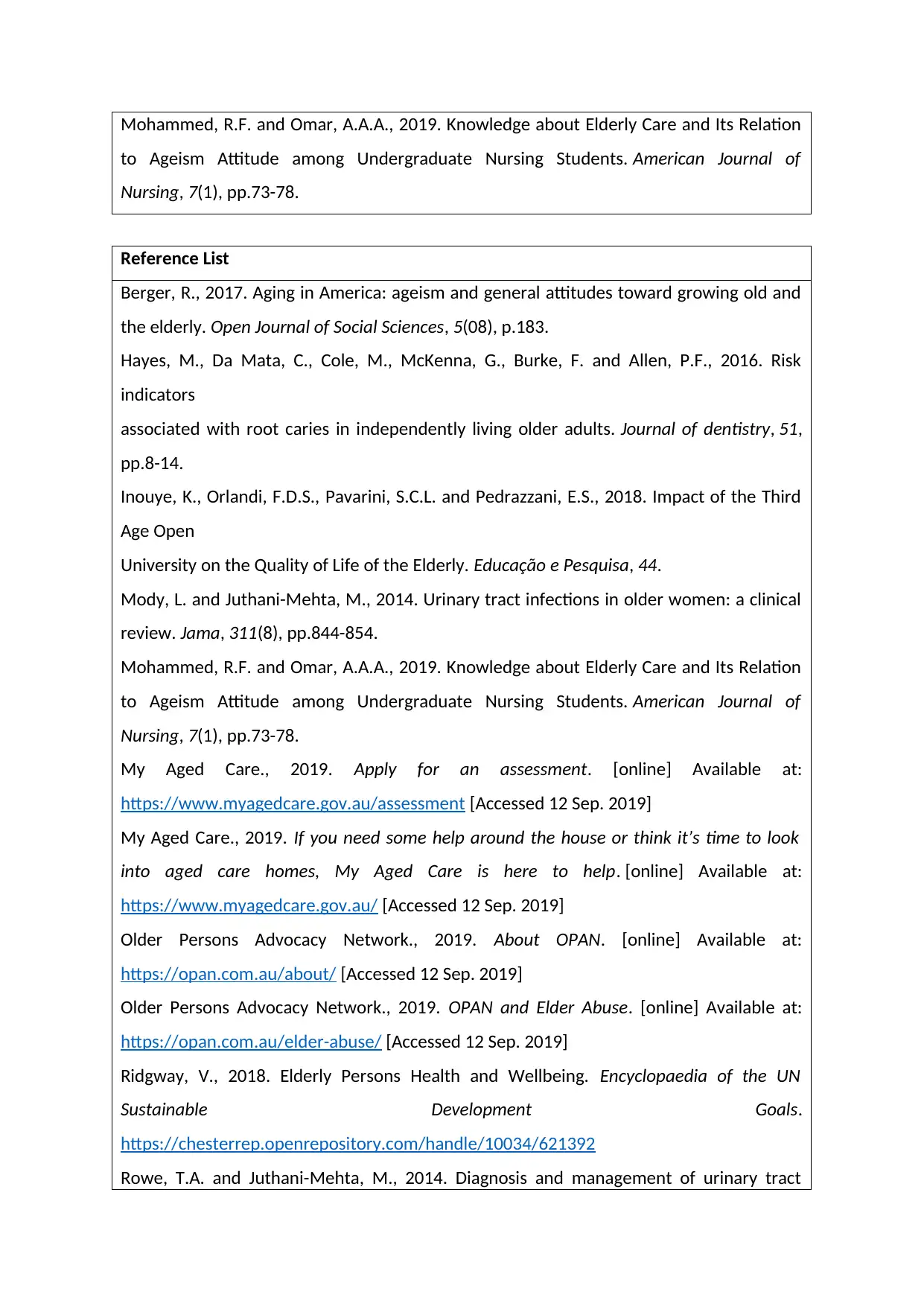
Mohammed, R.F. and Omar, A.A.A., 2019. Knowledge about Elderly Care and Its Relation
to Ageism Attitude among Undergraduate Nursing Students. American Journal of
Nursing, 7(1), pp.73-78.
Reference List
Berger, R., 2017. Aging in America: ageism and general attitudes toward growing old and
the elderly. Open Journal of Social Sciences, 5(08), p.183.
Hayes, M., Da Mata, C., Cole, M., McKenna, G., Burke, F. and Allen, P.F., 2016. Risk
indicators
associated with root caries in independently living older adults. Journal of dentistry, 51,
pp.8-14.
Inouye, K., Orlandi, F.D.S., Pavarini, S.C.L. and Pedrazzani, E.S., 2018. Impact of the Third
Age Open
University on the Quality of Life of the Elderly. Educação e Pesquisa, 44.
Mody, L. and Juthani-Mehta, M., 2014. Urinary tract infections in older women: a clinical
review. Jama, 311(8), pp.844-854.
Mohammed, R.F. and Omar, A.A.A., 2019. Knowledge about Elderly Care and Its Relation
to Ageism Attitude among Undergraduate Nursing Students. American Journal of
Nursing, 7(1), pp.73-78.
My Aged Care., 2019. Apply for an assessment. [online] Available at:
https://www.myagedcare.gov.au/assessment [Accessed 12 Sep. 2019]
My Aged Care., 2019. If you need some help around the house or think it’s time to look
into aged care homes, My Aged Care is here to help. [online] Available at:
https://www.myagedcare.gov.au/ [Accessed 12 Sep. 2019]
Older Persons Advocacy Network., 2019. About OPAN. [online] Available at:
https://opan.com.au/about/ [Accessed 12 Sep. 2019]
Older Persons Advocacy Network., 2019. OPAN and Elder Abuse. [online] Available at:
https://opan.com.au/elder-abuse/ [Accessed 12 Sep. 2019]
Ridgway, V., 2018. Elderly Persons Health and Wellbeing. Encyclopaedia of the UN
Sustainable Development Goals.
https://chesterrep.openrepository.com/handle/10034/621392
Rowe, T.A. and Juthani-Mehta, M., 2014. Diagnosis and management of urinary tract
to Ageism Attitude among Undergraduate Nursing Students. American Journal of
Nursing, 7(1), pp.73-78.
Reference List
Berger, R., 2017. Aging in America: ageism and general attitudes toward growing old and
the elderly. Open Journal of Social Sciences, 5(08), p.183.
Hayes, M., Da Mata, C., Cole, M., McKenna, G., Burke, F. and Allen, P.F., 2016. Risk
indicators
associated with root caries in independently living older adults. Journal of dentistry, 51,
pp.8-14.
Inouye, K., Orlandi, F.D.S., Pavarini, S.C.L. and Pedrazzani, E.S., 2018. Impact of the Third
Age Open
University on the Quality of Life of the Elderly. Educação e Pesquisa, 44.
Mody, L. and Juthani-Mehta, M., 2014. Urinary tract infections in older women: a clinical
review. Jama, 311(8), pp.844-854.
Mohammed, R.F. and Omar, A.A.A., 2019. Knowledge about Elderly Care and Its Relation
to Ageism Attitude among Undergraduate Nursing Students. American Journal of
Nursing, 7(1), pp.73-78.
My Aged Care., 2019. Apply for an assessment. [online] Available at:
https://www.myagedcare.gov.au/assessment [Accessed 12 Sep. 2019]
My Aged Care., 2019. If you need some help around the house or think it’s time to look
into aged care homes, My Aged Care is here to help. [online] Available at:
https://www.myagedcare.gov.au/ [Accessed 12 Sep. 2019]
Older Persons Advocacy Network., 2019. About OPAN. [online] Available at:
https://opan.com.au/about/ [Accessed 12 Sep. 2019]
Older Persons Advocacy Network., 2019. OPAN and Elder Abuse. [online] Available at:
https://opan.com.au/elder-abuse/ [Accessed 12 Sep. 2019]
Ridgway, V., 2018. Elderly Persons Health and Wellbeing. Encyclopaedia of the UN
Sustainable Development Goals.
https://chesterrep.openrepository.com/handle/10034/621392
Rowe, T.A. and Juthani-Mehta, M., 2014. Diagnosis and management of urinary tract
Paraphrase This Document
Need a fresh take? Get an instant paraphrase of this document with our AI Paraphraser
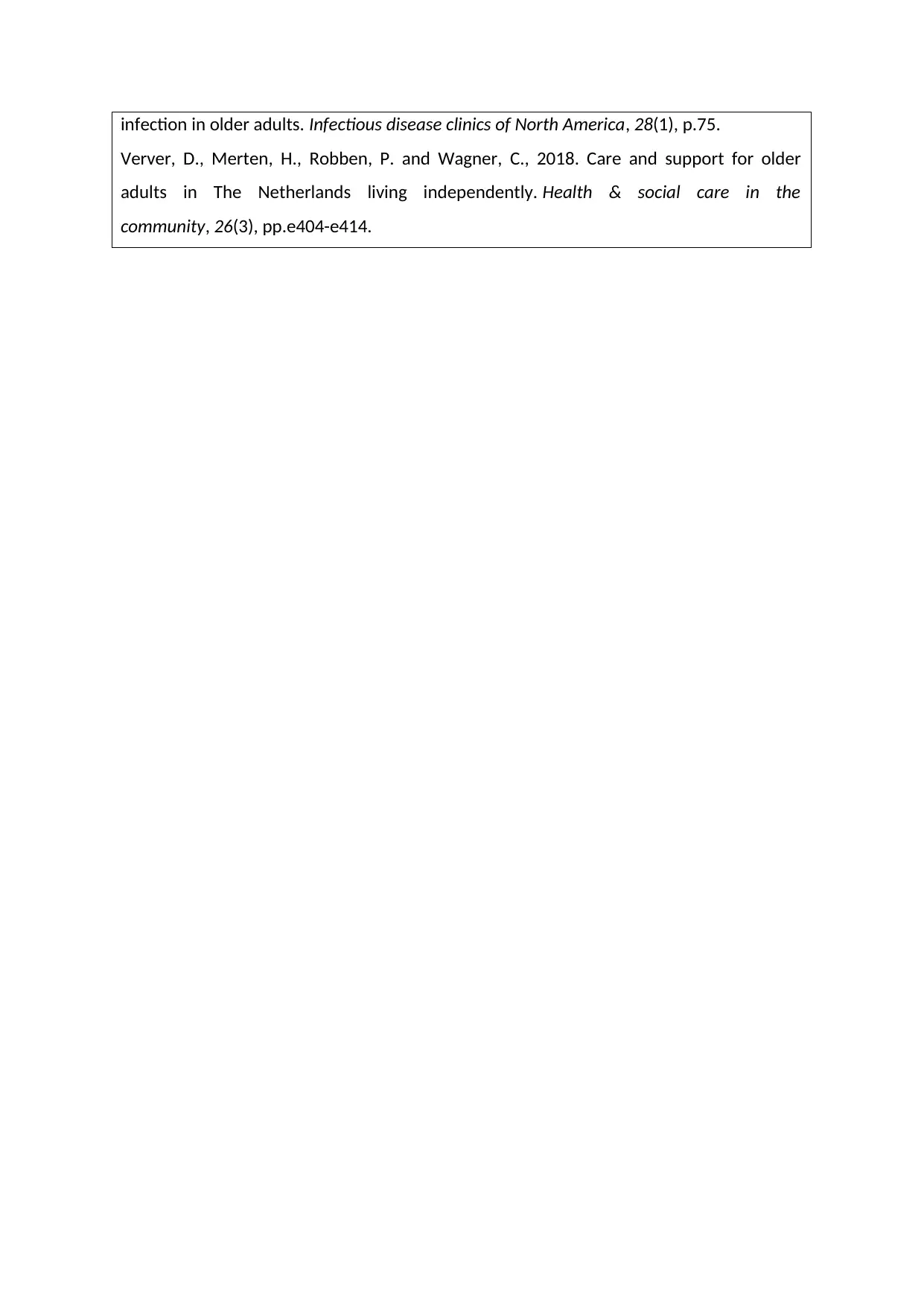
infection in older adults. Infectious disease clinics of North America, 28(1), p.75.
Verver, D., Merten, H., Robben, P. and Wagner, C., 2018. Care and support for older
adults in The Netherlands living independently. Health & social care in the
community, 26(3), pp.e404-e414.
Verver, D., Merten, H., Robben, P. and Wagner, C., 2018. Care and support for older
adults in The Netherlands living independently. Health & social care in the
community, 26(3), pp.e404-e414.
1 out of 8
Related Documents
Your All-in-One AI-Powered Toolkit for Academic Success.
+13062052269
info@desklib.com
Available 24*7 on WhatsApp / Email
![[object Object]](/_next/static/media/star-bottom.7253800d.svg)
Unlock your academic potential
© 2024 | Zucol Services PVT LTD | All rights reserved.




